One word of warning is needed: beware, the list is incomplete, its order is little less than random, and the items do not necessarily correspond to signals of new physics that are giving hints of being present in the data at the time of writing. There are, it is true, two-sigma discrepancies here and there, but who cares about two standard deviations nowadays ?
And another note: the plots I included below are thumbnails, and have not been commented in the text for brevity. You can click on them to get full-size pictures; an explanation is usually provided in the links I have put in the text.
1) Measurement of anomalous gauge boson couplings
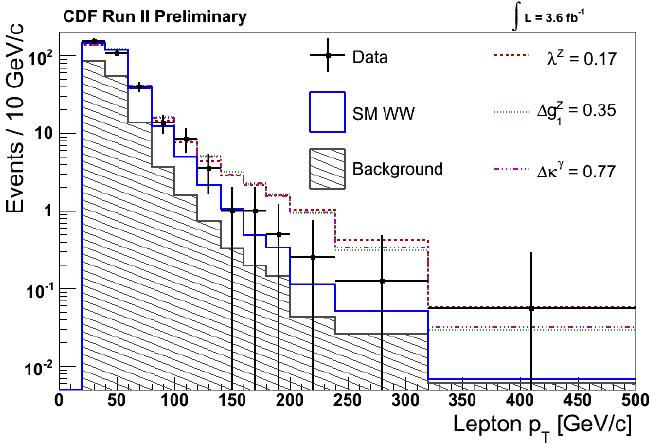 I have discussed recently the possibility that we detect a larger-than-expected number of boson pairs (WW, W-gamma, Z-gamma, etc) at large transverse momentum. In that article I explained that CDF does see a 2-standard-deviation excess in the WW final state. The events are rather background-free, so if this became a statistically significant excess we would need to think hard at what sources of systematic uncertainty may be present. I suspect that DZERO should be consulted before claiming an observation of anomalous couplings, because the competitor of CDF has a matching sensitivity for diboson final states.
I have discussed recently the possibility that we detect a larger-than-expected number of boson pairs (WW, W-gamma, Z-gamma, etc) at large transverse momentum. In that article I explained that CDF does see a 2-standard-deviation excess in the WW final state. The events are rather background-free, so if this became a statistically significant excess we would need to think hard at what sources of systematic uncertainty may be present. I suspect that DZERO should be consulted before claiming an observation of anomalous couplings, because the competitor of CDF has a matching sensitivity for diboson final states.2) Observation of a new Z' boson
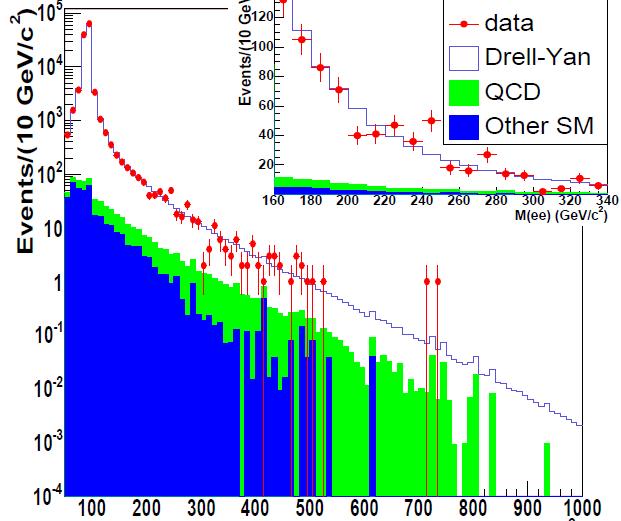 This is a pretty straightforward search: take events with two opposite-charge leptons of the same kind (an electron-positron pair, or a muon pair), and compute their invariant mass; then search for a bump in the mass spectrum. I discussed this search recently too, and I even gave hints that the regions to watch closely are those around 240 GeV and 720 GeV of mass. Again, we are talking of sub-alert-level excesses yet. But if a really significant bump were seen in such distributions, there would be very few or no raised hands to object the ascribing of the signal to a new physics source.
This is a pretty straightforward search: take events with two opposite-charge leptons of the same kind (an electron-positron pair, or a muon pair), and compute their invariant mass; then search for a bump in the mass spectrum. I discussed this search recently too, and I even gave hints that the regions to watch closely are those around 240 GeV and 720 GeV of mass. Again, we are talking of sub-alert-level excesses yet. But if a really significant bump were seen in such distributions, there would be very few or no raised hands to object the ascribing of the signal to a new physics source.3) Confirmation of anomalous muons, and electrons
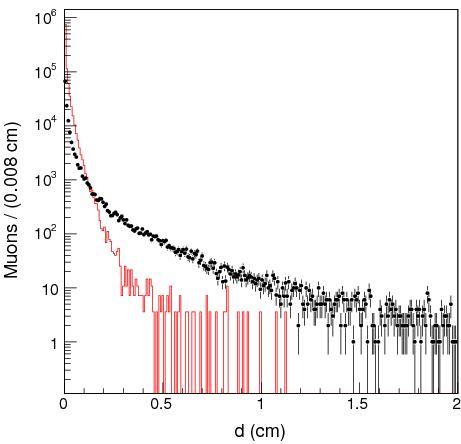 A paper submitted for publication last October 31st by CDF claimed the presence of a unknown source of events with a large number of muons, compatible with originating from long-lived, neutral particles of unknown nature. The effect is systematic, and CDF has so far been unable to disprove it by furthering the studies of its muon samples. DZERO, in the meantime, has searched for the same signature in its data but found no excess; the matter is not settled yet, though, because DZERO has been unable to prove that their capability to reconstruct tracks originating far from the interaction point is sufficient to be sensitive to such an anomalous signal. More investigations are needed, and if possible, a similar search should be tried with electrons, which are however quite difficult to handle in the kinematic regime where the muon events sit.
A paper submitted for publication last October 31st by CDF claimed the presence of a unknown source of events with a large number of muons, compatible with originating from long-lived, neutral particles of unknown nature. The effect is systematic, and CDF has so far been unable to disprove it by furthering the studies of its muon samples. DZERO, in the meantime, has searched for the same signature in its data but found no excess; the matter is not settled yet, though, because DZERO has been unable to prove that their capability to reconstruct tracks originating far from the interaction point is sufficient to be sensitive to such an anomalous signal. More investigations are needed, and if possible, a similar search should be tried with electrons, which are however quite difficult to handle in the kinematic regime where the muon events sit. 4) Observation of a new t' quark
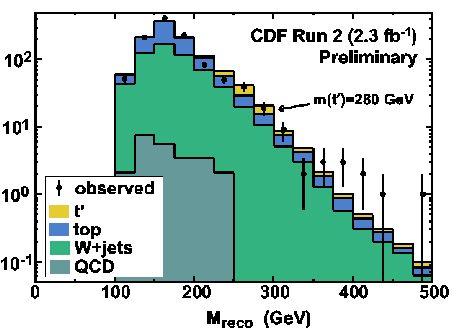 A search for a t' quark performed by CDF recently has evidenced a suggestive bump in the reconstructed mass distribution of event candidates; I discussed the matter in detail here (with a good introduction on the matter too). Of course, if those two standard deviations increased to four or five, this could make headlines as the discovery of the decade: a fourth generation of quarks is not something many expect to see.
A search for a t' quark performed by CDF recently has evidenced a suggestive bump in the reconstructed mass distribution of event candidates; I discussed the matter in detail here (with a good introduction on the matter too). Of course, if those two standard deviations increased to four or five, this could make headlines as the discovery of the decade: a fourth generation of quarks is not something many expect to see.5) Measurement of a strong phase in B_s mixing
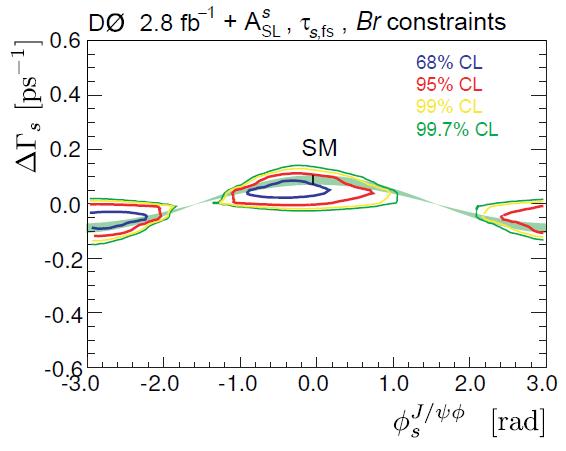 This is a complicated measurement involving a very careful study of mesons made by a bottom and a strange quark; I discussed it recently here. These particles can mix with their antiparticles, and produce striking oscillation phenomena, giving access to otherwise hard-to-measure parameters of the standard model(SM). Right now, one of these parameters shows a deviation at about 2-sigma level from SM predictions. Supersymmetric models have a means of making the parameter different from the SM value, so a precise measurement of this phase could be a way to both demonstrate the existence of physics beyond the standard model, and to show that Supersymmetry is to be taken as the default hypothesis.
This is a complicated measurement involving a very careful study of mesons made by a bottom and a strange quark; I discussed it recently here. These particles can mix with their antiparticles, and produce striking oscillation phenomena, giving access to otherwise hard-to-measure parameters of the standard model(SM). Right now, one of these parameters shows a deviation at about 2-sigma level from SM predictions. Supersymmetric models have a means of making the parameter different from the SM value, so a precise measurement of this phase could be a way to both demonstrate the existence of physics beyond the standard model, and to show that Supersymmetry is to be taken as the default hypothesis.6) Observation of large branching fraction of B_s mesons to muon pairs
 The standard model predicts that B_s mesons decay to muon pairs less than once in a billion cases. If we found a larger rate, we would know there is something fundamentally unexplained in the physics of these mesons. The most likely explanation would then be that new unknown massive particles catalyze these decays, and such particles would most likely be SUSY partners of standard model fermions. Since this search is quite straightforward, and its results do not require complicated models to be interpreted, a clear decay signal exceeding the SM rate would be a definitive proof of physics beyond the standard model.
The standard model predicts that B_s mesons decay to muon pairs less than once in a billion cases. If we found a larger rate, we would know there is something fundamentally unexplained in the physics of these mesons. The most likely explanation would then be that new unknown massive particles catalyze these decays, and such particles would most likely be SUSY partners of standard model fermions. Since this search is quite straightforward, and its results do not require complicated models to be interpreted, a clear decay signal exceeding the SM rate would be a definitive proof of physics beyond the standard model. 7) Evidence of large extra dimensions
CDF and DZERO are searching for events where a particle disappears in another dimension. This would provide a striking signature, and would be easily recognizable as new physics. I discussed recent searches of this kind here.
8) Observation of exotic hadrons
Of course, the discovery of molecular states, pentaquark hadrons, etcetera would be exciting; it is not clear, however, that these might be ascribed to Physics beyond the standard model, since quantum chromodynamics contains no definite rule against such states.
10) Observation of top-antitop resonances
If you have a large sample of top-antitop events, you may be tempted to reconstruct the total mass of a hypothetical particle X which decayed to produce the two top quarks. The Tevatron experiments have been doing this for a while now, but apart from some early excitement, the mass distribution of X candidates appears to closely follow expectations - for the time being.
11) Observation of a Supersymmetric Higgs boson
If Supersymmetry (SUSY) is the theory, then one of its five Higgs bosons might be at reach of the Tevatron experiments, depending on the value of a few of the many parameters describing SUSY. We could be seeing such a signal popping out any time in that case, in the tau-pair final state, or in its decay to b-quark pairs, accCDF first, and DZERO later, had tentatively a signal of supersymmetric Higgs in their data, CDF in the tau-pair mode and DZERO in the multi-b-jets mode. Both fizzled out with larger statistics. But one never knows...
12) Observation of Squarks and Gluinos
These things, which are predicted by SUSY models, have been searched extensively by CDF and DZERO since Run I. One looks for events with many jets and a large amount of missing energy, which might originate from the escape of a neutralino. So far, nothing to report. But the large cross section predicted for squarks and gluinos by SUSY theories make a signal quite at reach of the Tevatron experiments, for some values of the parameters.
* * *
The list, of course, could go on. Indeed, the about 1000 physicists working for CDF and DZERO are doing their best to cover all the above, plus scores of additional searches for Physics beyond the standard model. It must be noted, however, that despite the coverage of these signals most of the effort is concentrated elsewhere, on a few things that the Tevatron experiments can do better and/or sooner than the Large Hadron Collider. Among them, there are notably three important Physics measurements, which belong to the realm of standard model physics:
1) Exclusion of mass values of the standard model Higgs boson;
2) Measurement of the top quark mass;
3) Measurement of the W boson mass.
The above constitute part of the "core" program of Run II at the Tevatron, and must be pursued with momentum. As far as the Higgs is concerned, it is obvious that the Tevatron wants to say as much as possible on the existence of that particle before the LHC is capable of an overtaking sensitivity; the last two items in the short list, instead, require some explanation.
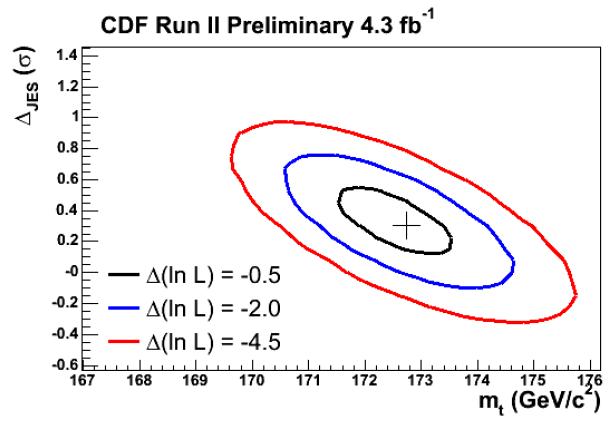 The LHC at full energy and luminosity will dwarf the Tevatron as a top quark-producing machine: the rate of top-pair production will be ten thousand times higher at CERN by then. Surprisingly, though, the top quark mass measurement obtained by CDF and DZERO will prove very hard to beat, despite the enormous advantage in available statistics provided by the LHC.
The LHC at full energy and luminosity will dwarf the Tevatron as a top quark-producing machine: the rate of top-pair production will be ten thousand times higher at CERN by then. Surprisingly, though, the top quark mass measurement obtained by CDF and DZERO will prove very hard to beat, despite the enormous advantage in available statistics provided by the LHC. The reason is that the measurement of the top quark mass is by now dominated by systematic uncertainties (most notably, the jet energy scale), and the systematic uncertainties which the Tevatron faces in the measurements of the top mass are smaller than those that will plague CMS and ATLAS. The size of systematic uncertainties does decrease with the increase of sample sizes -albeit less fast than do statistical errors-, and eventually the LHC is expected to surpass the precision of the Tevatron; but given the amazing job that CDF and DZERO have done, reaching a precision of 0.7% in the top mass value, one expects that it will take many, many years before the best measurement becomes property of CERN.
A similar argument can be made for the W boson mass: here the production rate will not be ten thousand times higher, but "only" a few thousand. Again, the problem comes from systematics, which in this case involve the ultra-precise knowledge of the lepton energy scale, and the understanding of parton distribution functions in a kinematical regime which is much less-well known at the LHC. Again, these factors favor the Tevatron. A precision below 20 MeV on the W boson mass is expected by O(10/fb) measurements of CDF and DZERO, and it is a tough call whether the LHC will ever beat that.
All in all, the Tevatron emerges as a giant in the landscape of particle physics accelerators, thanks to its invaluable scientific output, which has been continuing uninterrupted for over twenty years of operation. I can only hope that the Large Hadron Collider will be able to outdo that, but I believe I will be a retired chessplayer by the time that happens.




Comments